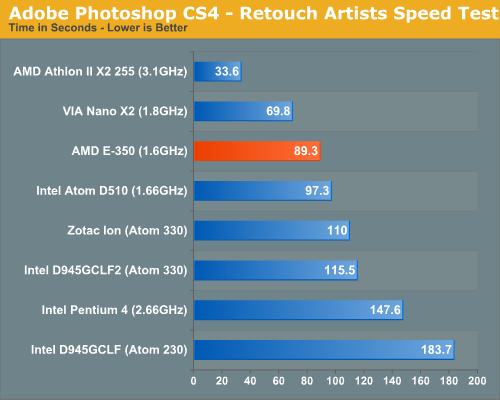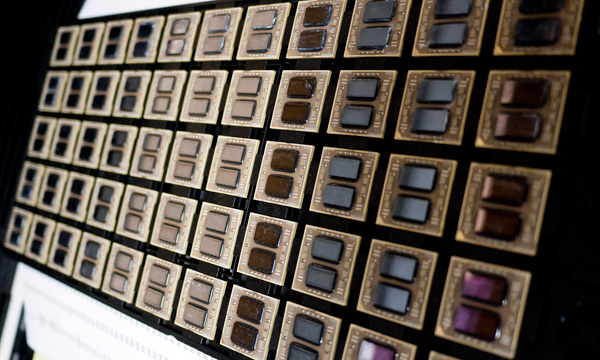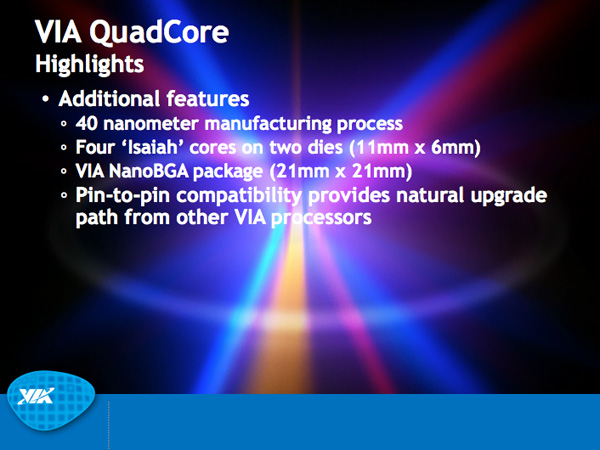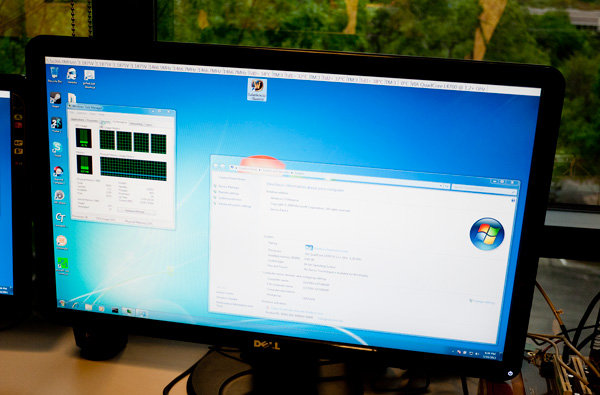VIA's QuadCore: Nano Gets Bigger
by Anand Lal Shimpi on May 12, 2011 3:01 AM ESTTwo days ago I flew out to VIA's Centaur headquarters in Austin, Texas to be briefed on a new CPU. When I wrote about VIA's Dual-Core Nano I expected the next time we heard from VIA about CPUs to be about its next-generation microprocessor architecture. While Nano still holds a performance advantage over Atom and Bobcat, it's still missing a number of key architectural innovations that both Intel and AMD have adopted in their current generation hardware (e.g. GPU integration, power gating).

VIA's dual-core Nano, faster than AMD's E-350 and Intel's Atom
Much to my surprise, the meeting wasn't about VIA's next-generation microprocessor architecture but rather the last hurrah for Nano: a quad-core version simply called the VIA QuadCore.
VIA's QuadCore architecture is nothing too surprising. At a high level the chip is composed of two dual-core die connected by a shared 1333MHz FSB, very similar to the old dual-core Pentium D processors. Each dual-core die has two 1MB independent L2 caches, for a total of 4MB of L2 on-package.

VIA's QuadCore, in production today
Going a little deeper there's an AMD-like 64KB L1 instruction and 64KB L1 data cache per core. The Nano is of course fully 64-bit x86 compatible, supporting up to SSE4. Each core is a 3-issue out-of-order design, giving it a general throughput and performance advantage over Intel's Atom and AMD's Bobcat. Remember that Atom is a 2-issue in-order architecture and Bobcat is 2-issue out-of-order. The wider front end for Nano gives VIA the ability to perform well in more complex workloads.

In the past power consumption has been an issue for VIA's Nano, however the QuadCore is built on a 40nm process which helps reel in power consumption. At 1.2GHz, VIA's QuadCore still carries a 27W TDP. Add another 5W for the integrated graphics chipset and you're talking about 32W, nearly double of AMD's dual-core E-350 Brazos platform. VIA claims that at lower clock speeds it can significantly reduce TDP, however the 1.2GHz QuadCore is the only part being announced today.
VIA is calling the 1.2GHz part a 1.2GHz+ QuadCore since it can use available TDP headroom to overclock itself by up to another two bins (133MHz per bin - 1.46GHz max). The chip doesn't support power gating, just aggressive clock gating.

Like all Nano parts, the QuadCore features a hardware AES encryption engine. VIA has added support for SHA-384 and SHA-512 as well.
Although there are still a considerable number of dual-core platforms sold in the market today, designs with four beefy processor cores seem to be where the world as a whole is headed. With its 2011 15/17-inch MacBook Pro and iMac updates, Apple no longer offers a dual-core option in those systems. By the time we move to 22nm I wouldn't be too surprised if the 13-inch MacBook Pro was quad-core only as well.
VIA moving to four cores makes sense and the QuadCore design was an obvious step. Even Intel used a dual-die approach to make the most of its existing microprocessor design before starting from scratch for Nehalem.
As odd as it sounds, VIA's QuadCore actually has a small but viable position in the market. At 27.5W the TDP is too high for a tablet like the iPad, and its performance will be too low to compete with ultra portable Sandy Bridge designs. What VIA could offer however is a a higher performing alternative to Brazos but at a better price than an ultraportable Sandy Bridge notebook.

The bigger issue VIA has to face is the lack of OEM adoption. The QuadCore will launch with whitebox and motherboard designs, not with slick design wins from companies like ASUS or Samsung. With less than 1% of the x86 market, VIA can't command the sort of attention that Intel or even AMD can. That being said, I do believe there's a small window of opportunity here. A clever OEM could put out a system priced similarly to a Brazos (if not lower than), with better performance based on VIA's QuadCore. I haven't looked at the current state of VIA's graphics drivers but when we previewed the dual-core Nano I came away pleasantly surprised. I suspect there will still be issues there going forward, but I remember something an old friend once told me: there are no bad products, just bad pricing. At the right price, in the right system, VIA's QuadCore could work.











36 Comments
View All Comments
tipoo - Thursday, May 12, 2011 - link
"i'd be interested in seeing how that competes with i7 "It won't. The Nano competed with the Atom, the dual core one with dual core Atom and Brazos, this one probably aims a bit higher at ultraportable laptops. It's definitely not a high end i7 competitor. Maybe a ULV competitor, but its wattage ratings aren't even that good, hence why I was confused about its purpose in my comment above yours.
simple_inhibition - Thursday, May 12, 2011 - link
im thinking that soulkeeper was talking about AES encryption, something that VIA cpu's have always excelled and even lead at in comparison to AMD and Intel. with Intel rocking AES-NI instructions on their latest and greatest, it would be an interesting comparison between the 800lb gorilla and the 24 chips at a time VIAswaaye - Wednesday, May 18, 2011 - link
VIA has had AES hardware in their CPUs for generations, probably because the companies that use VIA CPUs require it for their applications. It's not something that's particularly useful to have in the CPU in many situations though.GullLars - Wednesday, May 25, 2011 - link
I'm also interrested in seing how the AES of VIA stacks up against i7s. It could make for a good budget crypto-fileserver on Gbit network when paired with an older cheap RAID controller (like PERC, Adaptec 5xxx, or HighPoint X3xx/x4xx).L. - Monday, May 23, 2011 - link
It's not going to compete, by the time it's out and gets a tiny wee bit of market adoption it'll be slaughtered by 32nm products from both Intel and AMD , and on the lower side by ARM designs .. maybe 6 months earlier it could have been useful .At least it show there's competition, always a good thing.
ZL1Corvette - Thursday, May 12, 2011 - link
I wonder if you bumped into any other hardware site people while you were there?Veerappan - Friday, May 13, 2011 - link
I'm thinking so. One of those pictures was very similar to one I saw on TR yesterday afternoon (guy in front of wall-sized die shot). You can also hear a few voices in the background of that first video explaining things.ICBM - Thursday, May 12, 2011 - link
I have used several single core nano itx boards here at the office. Performance has been good for single core. I have been waiting since the dual core announcement for those to show up, but still nothing.When will VIA have boards with the dual-core chip? What about board availability with quad-core?
krumme - Thursday, May 12, 2011 - link
At its very best for many years. The world has not come to an end yet :)Its so damn impressive VIA can survive this game.
ICBM - Thursday, May 12, 2011 - link
For how long though. :(